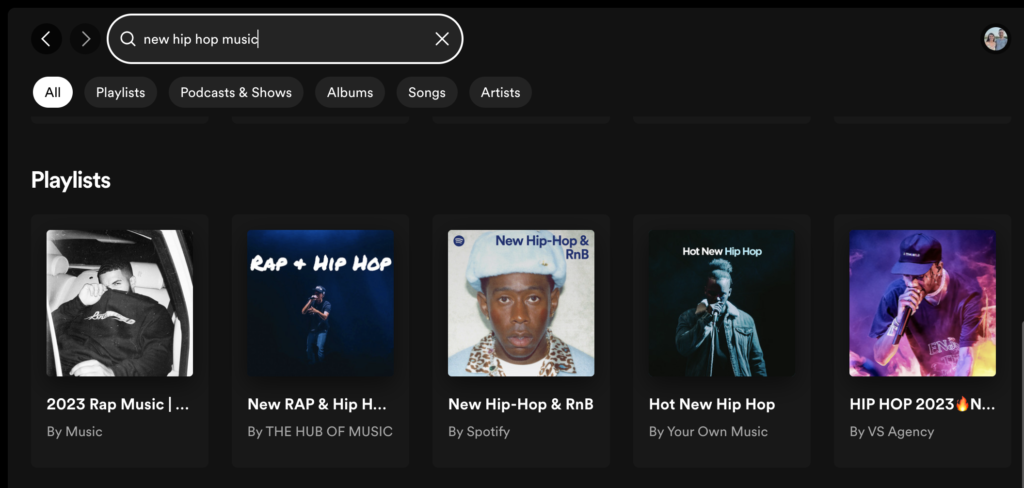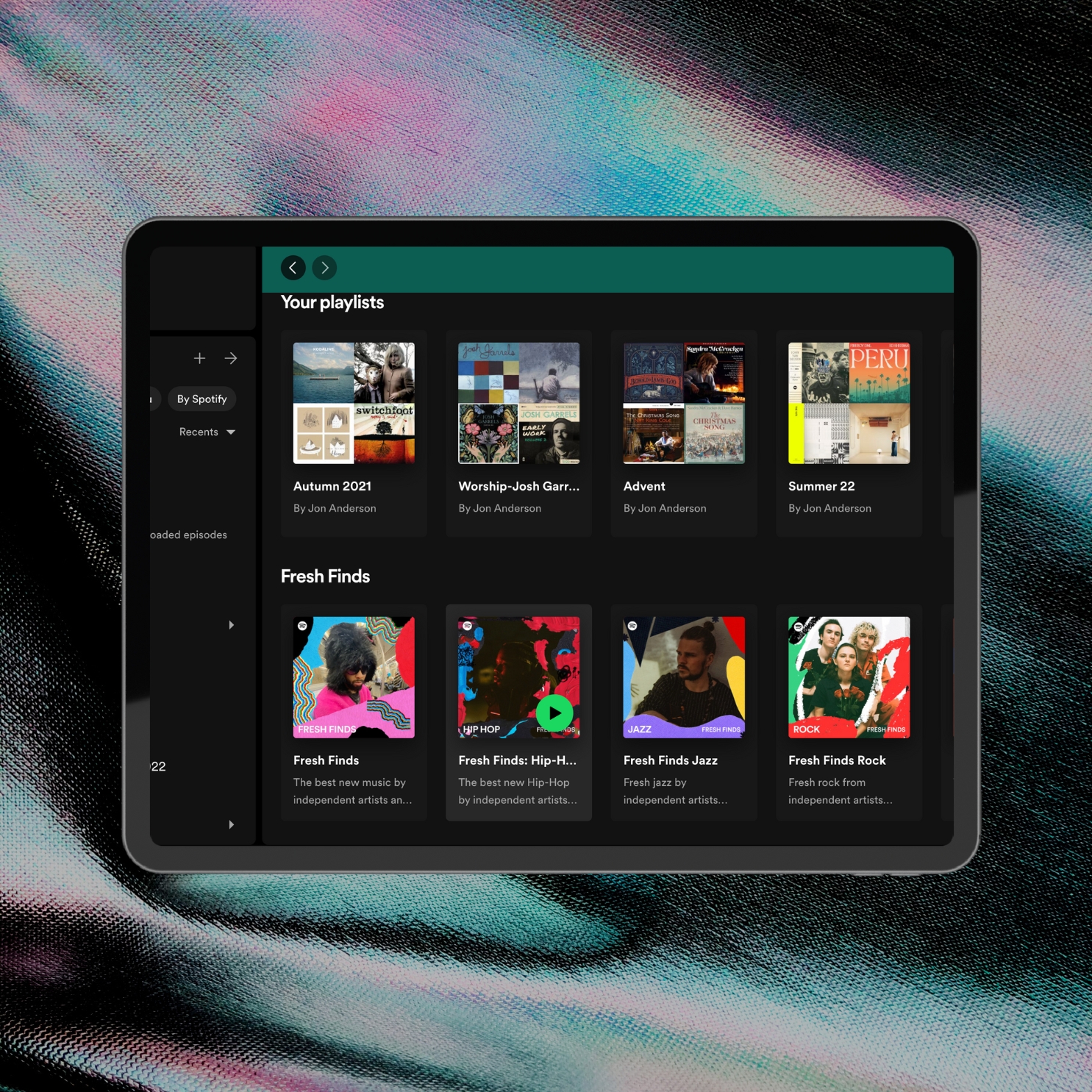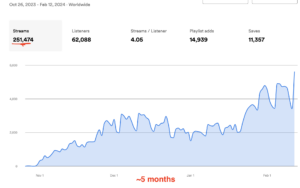I’ll start with this: Despite what you may hear from different corners of the internet, playlisting can potentially be hugely helpful for getting your music in front of more people. The right playlist placement can literally rocket your career to the next level.
That benefit (getting a bunch of people to listen to and like your music) is pretty much the dream outcome for most musicians. Artists want that. And, as with other dream outcomes (i.e., “make a million bucks online” or “get a six pack” or whatever), the fact that it’s so appealing has led to the rise of a whole swath of services promising to deliver the result – some legitimately, and some through snake oil salesmanship.
All of this is to say that playlisting is the source of both deserved hype and confusion.
In this guide, I’m going to try to clear things up.
I’ve run a music marketing agency for the past five years. In that time, I’ve run dozens of playlisting campaigns myself, and I’ve spent thousands of dollars testing other playlisting services to see what works and what doesn’t.
Here’s the good news: Playlisting, done right, really does work. It certainly can drive huge spikes of streams, and even better, it can also lead to steady, long-term growth. That’s the dream outcome – but you’ve got to know what you’re doing to make it happen.
With that said, welcome to the complete guide to playlisting in 2023. Let’s get into the details.
What is playlisting?
Let’s start with a definition:
Playlisting is any activity that results in a piece of content being added to a list of content. Usually, playlisting is done to group related content together, with the intent being that the content on the playlist will be consumed (listened to or watched) in a specific setting or at a specific time.
And in case it wasn’t clear from that: A playlist is a list of content (usually videos or songs) that is meant to be played together, either sequentially or in a shuffled order.
A bit of backstory here: Playlisting started with radio; rather than scrambling to play random song after random song, radio DJs create a list of songs to be played during certain segments. It became popularized with consumers with the rise of .mp3 players (like the iPod, RIP).
And when music moved to streaming, playlisting became even more important; it’s probably the dominant mode of media consumption today.
Certainly, far more people listen to playlists than albums. An old study found that 31% of listening time is accorded to playlists versus 22% for albums. While I can’t find more recent data, it seems pretty likely that that disparity has only increased over the past few years.
It’s worth mentioning that when people talk or write about playlisting, they’re typically referring to song playlisting – and even more specifically, they’re most often referring to Spotify playlisting.
I’ll get into why this is the case shortly, but for now, I want to note that over the rest of this guide, when I use the term “playlisting,” I’ll be referring to song playlisting on a music streaming service (rather than, for example, video playlisting or radio playlisting). I’ll also clarify when I’m referring to Spotify playlisting in particular.
With that said…
What are the benefits of playlisting?
It’s a little obvious, but here’s why playlisting gets so much hype:
1. Playlisting is an effective way to get more people hear your music.
Playlists are the foundation that modern streaming platforms are built on. Scroll through Spotify’s home screen and you’ll see the proof.

As I just referenced above, at least a third of music today is listened to via playlists (and again, I think at this point, it’s probably higher than that). So it makes sense that if you want your music to be heard by more people, you’ll probably want your music to be added to more playlists.
2. Playlisting can help streaming platforms categorize your music.
Artists are typically resistant to the boxes of genre categorization – but algorithms sure aren’t. Getting your song added to high-fit playlists can help to teach streaming platforms what your music is like and what kind of people like your music.
For instance, if you get added to a playlist called “Chill Acoustic Folk” that features a bunch of other artists making acoustic folk music, then streaming services will start to suspect that you make acoustic folk music, too. Generally, the more data streaming platforms have on this stuff, the better able they are to show your music to more people who will probably like it.
On the flip side, though, if you get added to a playlist that isn’t a good fit, it can hurt algorithmic perceptions of your music. So an algorithmic boost is only a benefit if you do playlisting effectively.
Here’s Jason Grishkoff making this point in more detail.
Again, the ideal outcome is that streaming services properly categorize your music and show it to more people.
3. Playlisting can lead to more fans and more income.
And of course the reason that you want to get your music heard by more people is that it leads to more fans and more income. People have to hear your music to become a fan of it, after all.
On the revenue front, things are a little bit more convoluted. The reality is that streaming doesn’t pay very much directly (Spotify, for example, pays between $.003 – $.005 per stream). Still, though, more streams do lead to more money. And when ancillary revenue streams outside of streaming royalties are considered (i.e., fans buying your merch or paying for tickets to a show), it’s clear that growing your fanbase can lead to more money in your pocket.
Okay, so those are the benefits. Now, if you’re tracking with me so far, you’re probably wondering…
How do I get onto playlists?
The answer to this question depends on the type of playlists you’re targeting, and things vary widely across different streaming platforms.
How to get onto Apple Music playlists
Bad news on this one: You don’t have much ability to get impact your inclusion on any Apple Music playlists (outside of your own private creations). That’s because Apple Music, unlike YouTube and Spotify, doesn’t really facilitate user-created content. People can’t follow playlists created by other random users.
It’s true that Apple Music does curate editorial playlists, like Today’s Hits and Rap Life and Today’s Christian, and there are some agencies that claim to be able to impact your inclusion on these. As Hypebot notes, it also helps if you…
- Verify your artist profile with Apple Connect
- Build a following on Apple Music (more followers and streams make you more likely to catch the eye of an editor)
- Work with a distributor that has relationships with Apple’s editorial team (pretty much all distributors claim to do this ha).
But the reality is that, unless you know a playlist editor at Apple Music personally, you probably don’t have a means of direct influence. (While you can find contact info for editors online, I’ve literally never had any luck soliciting placements with cold outreach… and I’ve tried.)
The harsh truth is that, typically, big label artists get added and small indies don’t.
The lesson is that, if you’re considering playlisting, your time is probably best spent on other platforms.
How to get onto YouTube playlists
While Apple Music is a pretty closed-door system, YouTube is built on user-generated content. That means that you have many more chances to get your music onto YouTube playlists.
It’s worth noting that, in YouTube parlance, a “playlist” is technically a list of videos – but, most often, playlisting on Youtube is done via a single video that incorporates, in itself, an entire list of like-sounding songs.
For example, here’s a playlist of “Chillhop Essentials” from YouTube channel Chillhop music:
And here’s a playlist of “sad indie songs when you need a good cry” from alexrainbirdMusic:
If you’re looking for more YouTube playlist curators in your own genre, here’s a good starting list from Promolta.
The way to get on these “playlists” is pretty simple: You just reach out to the curator and ask to be included.
Many of these curators are actively looking for submissions, and often, you’ll find their preferred mode of contact listed in the “About” section of their channel.
For example, go to alexrainbirdMusic’s “About” section, and you’ll see that they take submissions via their website and their SubmitHub profile. Click through at the links they provide and follow the guidelines they put out, and you’ll typically find that sending in your music is pretty straightforward. (Getting accepted is another thing, but hey.)
There is one important final note on YouTube playlisting, though: It’s important that you give YouTube curators permission to upload your song to their channel.
There are copyright issues at play here. Basically, YouTube tries to flag videos that use unauthorized assets (like songs or clips from movies or whatever), and curators that violate copyrights can have videos taken down. As a result, curators will usually ask you to check some box that says you give permission for them to use your song.
If you’ve distributed with a YouTube Content ID, you may need to “whitelist” a channel to allow them to upload a monetized video featuring your music. As an example, here’s how DistroKid manages the process.
I’ve had some clients who feel a little sketched out by this whole thing, but my take is that, if you’re an indie artist, you’re probably best served by prioritizing audience building rather than stressing over permissions.
If the curator has an audience that overlaps with your own, it’s usually worth it to let them use your song in a video.
How to get onto Spotify playlists
Okay, now we’ve come to the big one: Spotify playlisting.
Spotify playlisting is hugely popular for two reasons:
- Spotify is the world’s most popular music streaming platform (so getting streams here matters).
- Spotify offers the most avenues toward impacting your inclusion on playlists.
There are so many avenues toward Spotify playlisting because Spotify features three distinct types of playlists: editorial playlists, algorithmic playlists, and user-created playlists.
And this is a large part of the reason why, as I mentioned at the outset of this article, the internet most often means Spotify playlisting when it talks about playlisting.
I have a whole article about how to get on Spotify playlists and a whole piece on that breaks down the three different types of Spotify playlists – but for now, I’ll just walk through how to actually get onto each one.
How to get onto Spotify editorial playlists
There’s only one official way onto a Spotify editorial playlist: the Spotify for Artists editorial playlist pitching tool.
Here’s how it works:
- You should upload your music to your distributor at least three weeks before your planned release date.
- When Spotify receives your music from your distributor, they’ll list it in your Spotify for Artists profile under the “Upcoming” tab.
- From that tab, you can pitch your music for inclusion in Spotify editorial playlists. Focus on helping editors understand where your song fits rather than going into copious backstory.
- Spotify editors will (ostensibly) listen to your song and (very occasionally) add it to an editorial playlist.
I’ll be honest: Most of the time, you’ll hear nothing back and your song won’t get placed in any editorial playlists.
But once in a while, if you consistently release good music, you’ll strike gold. And when that happens, you’ll rack up a bunch of streams very quickly (depending on the list, we’re talking thousands of streams over the course of a few days).
While this is rare, it’s pretty much always worthwhile to submit through the pitching tool. It’s like getting a free lottery ticket – why not, right?
How to get onto Spotify algorithmic playlists
You don’t really have any way to directly impact Spotify’s algorithmic playlists – lists like Daily Mix or Discover Weekly or Radio.
But the general rule of thumb is that, the more good data you feed Spotify, the more likely they are to include your music in algorithmic playlists. Remember, Spotify wants to show users good music that they’ll probably like. The more Spotify knows about your music, the easier time it’ll have figuring out who to show it to and where to place it.
The simple way to say this: More good streams lead to more good streams.
How to get onto Spotify user-created (third-party) playlists
Finally, you can pitch Spotify users with popular playlists directly (much in the same way that you can on YouTube).
Because Spotify allows public, user-created playlists, there’s a whole ecosystem of third-party created lists with tons of followers. Search for “new hip hop music,” for example, and you’ll see that most of the playlists that appear are curated by users rather than Spotify editors.

As with YouTube playlist curators, many of these Spotify curators are actively looking for submissions, and they’ll often include contact information in the playlist descriptions.
Here are a few ways to find curators and playlists to submit to:
- Look at the playlists your songs have already been included on by going to the “Music” tab of your Spotify for Artists profile. Go through and ask the curators of those lists to include other songs in your catalogue.
- Search 10 similar artists. Scroll to the “Discovered on” section of their Spotify profile and make a list of the playlists that would be a good fit for your music.
- Use a playlist finding tool like Artist Tools or Playlist Supply.
As you compile, it’s worthwhile to check the quality of each playlist – both for genre fit and engagement, and to ensure that a list isn’t populated with fake followers or bots.
The easiest way to tell if a playlist is fake: Plug it into a tool like isitagoodplaylist.com and check to make sure there aren’t spikes in followers. If the growth curve is smooth, the list is probably okay.
Once you’ve got a good list, go ahead and submit!
But be warned: Things can get a little sketchy. It’s fairly common for curators to ask for payment in exchange for placing your song on a list. This is technically payola, and it’s also against Spotify’s user guidelines. In a worst-case scenario, paying for placement can lead to your song getting removed from the platform.
The moral of the story: If you reach out to a curator and they ask for direct payment to place your song, don’t do it.
But don’t give up on playlisting entirely just because there are bad actors in the space.
Should I use a playlisting service?
And that brings me to my final topic in this guide: playlisting services.
(A note here for clarity’s sake: Most often, playlisting services focus on pitching your music to Spotify playlist curators, because, as I’ve explained above, that’s the platform that’s easiest to impact.)
Playlisting services get a bit of a bad rap. Some of that’s fair (there are definitely some scams out there) but, in my opinion, some of it isn’t. I’ve tried dozens of playlisting companies and spent thousands of dollars, and I’ve only run across three or four that I’d consider to be full-out scams. Most of these agencies are just trying to do their best in a difficult ecosystem.
With that said, here’s my high-level take on playlisting services: They’re a high-risk, high-reward play.
Even the best playlisting agencies – the ones that wouldn’t touch a bot with a hundred-and-ten-foot pole – can struggle to get good results. They’re oriented toward streaming numbers, which means they’re incentivized to put your song onto playlists that, while active, aren’t always necessarily the best fits.
In my experience, the result of a playlisting campaign is usually a spike in streams that lasts several weeks, followed by a return to normal numbers immediately after. In other words, most campaigns don’t drive long-term results (and you could argue that they hurt long-term results if they mismatch your song with strange playlists).
Sometimes (about 25% of the time, in my experience) though, a campaign will result in a spike that triggers long-term algorithmic growth. When this happens, it can literally represent a “next step” for an artist’s career – a “new normal” of streaming.
So yeah, paying a playlisting company is a high-risk, high-reward tactic – sometimes it works and sometimes it doesn’t. Most often, I’d recommend playlisting in tandem with another, lower-risk tactic, like Facebook ads.
But if you’re interested in trying it…
Here are five companies I’d recommend:
I’ve tried each of these companies personally (and a bunch of others, which you can see in more detail if you read my breakdown on the top playlisting services). Not every campaign is a huge success, but they’ve all generated real, legitimate streams from real, human listeners.
Final thoughts on playlisting
All right – I think that about covers it, and also my fingers are getting tired from all of this typing. Hopefully, this guide to playlisting has been helpful as you consider how to incorporate playlists into your own music marketing strategy.
I like to end these sorts of posts with this thought: Streams matter, but they only matter insomuch as they represent real people really listening to your music.
The ultimate goal of playlisting – or of any music marketing tactic, really – should not be to tick up the little numbers beside your songs on a screen. The real goal should be to create real connection around your music.
So don’t lose heart if you don’t have a million streams or if you get rejected by a bunch of playlist curators. Playlisting is just a means toward an end. Your music is an end in itself.
It matters; keep making it.
Here’s wishing you good luck.









